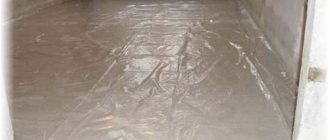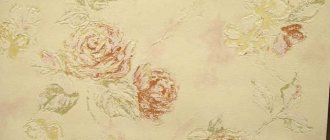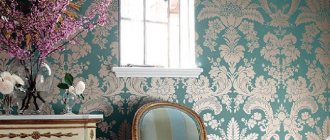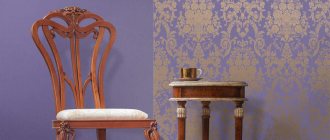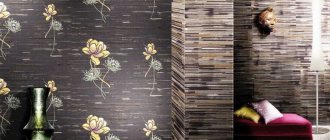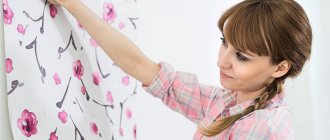Before gluing vinyl wallpaper, the material must be examined to ensure its quality and sufficient density. Gluing high-quality durable vinyl wallpaper is considered a rather difficult task. In addition, you need to prepare glue, special tools and materials, namely a bucket for preparing glue, scissors, a spatula, and a wallpaper roller. Covering walls with high-quality durable vinyl wallpaper requires some effort, but it is worth it, because such finishing material looks simply excellent on the wall. Be sure to purchase glue designed to work specifically with vinyl wallpaper.
Modern vinyl wallpaper with non-woven backing
Stylish vinyl wallpaper, made on a non-woven base, is in great demand because it is a fairly durable and high-quality material. Italian and German vinyl wallpapers are of very high quality, because they are made from the best materials, and therefore are durable, environmentally friendly, and have a modern design. Italy and Germany are considered leaders in the production of high-quality wall coverings.
Vinyl wallpaper is characterized by:
- Excellent design;
- The ability to hide wall imperfections;
- High quality and practicality.
Thanks to the variety of existing models, it is possible to introduce the most daring and modern ideas. A rich palette allows you to choose the desired option that best suits the stylistic design of the room.
Since vinyl wallpaper is characterized by increased durability, it can be used for painting, thereby changing the stylistic design of the room.
Important! In the production of vinyl wallpaper, foamed vinyl is used, which comes on a non-woven or paper base.
Vinyl wallpaper, made on a paper basis, is more environmentally friendly because it allows the walls to breathe freely. Vinyl wallpaper is characterized by resistance to high humidity, so it is easy to wash and clean, which is important when carrying out renovations in the kitchen and nursery. In addition, such material is capable of absorbing sounds.
Non-woven wallpaper
To produce non-woven fabrics, cellulose fibers are used, for the connection of which polyester and special impregnations are used, but even this factor does not reduce their high hygienic characteristics, therefore they are intended for gluing surfaces in residential premises.
They can also be used as a hypoallergenic material, especially if people who are prone to asthma or other allergic manifestations live in the house.
The use of cellulose for the manufacture of non-woven wallpaper makes it similar to paper wallpaper, but the use of a completely different production technology and processing of the source material gives these products qualities and properties, including:
- high strength of the fabric;
- no shrinkage during pasting;
- possibility of painting the pasted surface;
- resistance to fire;
- possibility of using a wet method of care;
- vapor permeability;
- ability to maintain shape;
- dust repellent.
The disadvantages of this material include its relatively low resistance to mechanical stress, as well as its high price.
Non-woven wallpaper made entirely from this material can be of several types:
- with applied relief;
- completely smooth;
- with a pattern, including for painting;
- basic white color, intended for further application of paint;
- factory painted.
How to properly glue vinyl wallpaper on non-woven backing: selection of materials
Wallpaper is considered the most popular material used for wall decoration. A rather interesting option is stylish vinyl wallpaper made on a non-woven backing.
Such wall finishing materials can be very different and they differ:
- Number of layers;
- Density;
- Weight.
Before gluing vinyl wallpaper, you need to use an additional layer of primer, which is applied to the wall
Related article: Gray-brown color in the interior, a combination of gray and brown
When choosing such wallpaper, you definitely need to know how to paste them correctly and what materials and adhesives are best to select. Before covering walls with stylish, durable vinyl wallpaper, it is best to initially prepare the surface and level it using special materials. However, it is worth remembering that when decorating walls you cannot use putty made on the basis of PVA glue, because this can harm the vinyl wallpaper.
Working in difficult places
Areas of the wall behind radiators, in corners, above window and door openings are considered difficult for gluing wallpaper.
- It will not be possible to use solid sheets behind radiators. A strip of a certain length is cut into 2-3 parts using a wave-like motion. Each piece is glued separately, trying to press it as tightly as possible against the wall. Here you should use a little more glue. The surface will heat up, so the thin layer of the composition will dry too quickly, and the wallpaper will come off.
- To cover the corners, it is recommended to glue two pieces together. The first canvas extends a few centimeters onto the next wall. The other edge is glued on top of it. Both canvases are cut through with a sharp knife, and excess thin strips are removed.
- The scraps left over from cutting the rolls are usually glued to the areas above the windows and doors.
Non-woven vinyl sheets are the best choice for beginners and the favorite material of professional finishers. After mastering the technology of applying this coating, the home craftsman will definitely have a desire to continue working with them further. The video below will help you get a visual idea of the process.
Which adhesive is best for non-woven vinyl wallpaper?
Many people are interested in what kind of glue is best for gluing vinyl wallpapers made on non-woven backing so that they stay on the walls for a long time and the aesthetic qualities of this material do not deteriorate. For gluing vinyl wallpaper, special adhesives are used or you can use universal wallpaper glue.
The main characteristics of this adhesive composition:
- High resistance to humidity;
- Increased sliding ability;
- Excellent adhesion to the wall.
When gluing vinyl wallpaper, you must choose the right adhesive composition and follow all the instructions.
Thanks to the peculiarities of the adhesive composition, it is possible to easily adjust the joints. In addition, this glue does not form lumps at all. Just a few minutes after dilution, the adhesive composition used for gluing vinyl wallpaper is completely ready for use, and the adhesive can be stored in a closed container for several weeks. Methylane glue, available in a wide range, is considered the most popular and popular. After reading user reviews, you can be convinced that this is an ideal adhesive for vinyl wallpaper.
Installation of non-woven wallpaper
The standard procedure for gluing surfaces with vinyl wallpaper involves the arrangement of strips without overlapping - it is correct to glue such sheets end-to-end. This is done because the material is thick, the overlaps will be too noticeable. Thanks to this feature, you can start work from anywhere in the room.
This will avoid possible unevenness and joints of the canvas in a visible place.
At the zero point it is necessary to draw a vertical line along which the first strip will be aligned.
This can be done using a plumb line or a building level. The width of the outlined strip should be 1.5-2 cm less than the width of the roll. This edge must be turned at an angle.
The wall is carefully coated with glue. Another feature of the non-woven backing is that it does not need to be treated with glue - just apply it to the wall. It is important to avoid gaps; apply a thick layer of glue in the corners and under the ceiling with a small brush.
Important! When the repair time was during the summer heat, it is better to treat not only the wall, but also the wallpaper with glue.
While the strip is being measured and cut, the wall may dry out due to the high temperature.
A piece of the required length is cut from the roll (2-5 cm is added to the height of the walls). The upper edge of the canvas is aligned with the line under the ceiling and aligned relative to the vertical line. Using a rubber spatula or wallpaper roller, press the strip in the center, moving from top to bottom.
Now you need to expel excess glue and air. To do this, move the spatula from the center to the edges. Remove excess glue with a clean rag.
Tip! If the edges do not fit tightly to the wall, you can stick thin paper or a special paper tape for wallpaper under the seam. This way the fabric will stick more securely and the seams will be less noticeable.
The wallpaper near the ceiling is cut with a sharp knife.
First, they are pressed to the corner with a metal spatula, without removing it, and a straight line is drawn with a knife. If a plinth is installed below, the lower edges can be trimmed with scissors. All the same, the baseboard will cover the cutting line.
Press the wallpaper into a vertical corner with a plastic spatula, preventing the accumulation of glue and air bubbles there.
Cut the next strip from the roll. If the wallpaper has a pattern, it is more convenient to work with several rolls at once - this will reduce the material consumption.
The second strip must be glued, focusing along the edge of the previous one. The seam should be invisible, so the canvases are placed as close to each other as possible, but avoiding overlap. Non-woven wallpaper is very elastic; tightening it a couple of millimeters will not be difficult.
If the strip is crooked, you can tear it off the wall and stick it on again. However, you should not abuse this; with each tear, the glue will shift, forming clumps.
Features of wall covering: how long does vinyl wallpaper on non-woven backing take to dry?
Vinyl wallpaper looks just great, but to hang it, you need to take into account the rules and do all the work in a clear sequence.
The process of covering walls with stylish high-quality vinyl wallpaper consists of several stages, namely:
- Preparation of materials;
- Wall pasting;
- Corner processing;
- Processing of sockets and switches.
Before sticking wallpaper on the wall, you need to check each individual roll for consistency in shade and pattern, and then cut each canvas into separate strips. The stripes need to be cut so that the pattern matches and creates a coherent pattern throughout the room. Working with vinyl wallpaper is especially simple, because the glue must be applied exclusively to the wall and it is not at all necessary to saturate the canvas itself with glue. In order for the wallpaper to lie flat on the wall, you need to make markings using a level before carrying out the work.
Corners require special attention. The canvas must be glued in such a way that only 5 cm extends into the corner, and the subsequent strip must be glued overlapping. Then you need to trim the double joint with a sharp knife and you can join the edges
At the time of wallpapering, all switches and sockets must be completely de-energized. The boxes themselves need to be removed and a cross cut should be made in the place of the socket or switch, and then the corners should be bent inward. After the wallpaper is completely dry, you can install the switches and sockets in their original places.
When wallpapering, it is very important to know how long it takes vinyl wallpaper to dry. They dry quite quickly, the most important thing is to prevent the formation of drafts. The wallpaper will dry literally within a day.
Related article: How to get rid of bedbugs in an apartment at home using folk methods
Features of the gluing process: preparation and stages
Stock up on construction tools!
- Knife and scissors - for cutting rolls.
- Paint roller – for applying glue to walls.
- Plastic spatula or roller - for smoothing wallpaper.
- Container for mixing glue.
- A plumb line and a pencil - for marking the walls.
- Small rubber roller - for rolling out joints.
Preparing a working tool
Thanks to the unique properties of the materials, they can be glued even in the bathroom and kitchen. Gluing vinyl wallpaper on a non-woven backing has very little in common with the standard process of laying wallpaper on the floor, soaking it with glue, etc.
You can attach wallpaper to almost any surface, but before doing this you should prepare the walls. It should be dry, smooth, uniform. Remove all old finishing (paper, tiles, plaster), and then the wall needs to be puttied and primed. Apply a layer of putty for complete leveling. To achieve the correct color, use primers in neutral shades.
Don't skimp on glue. Buy a special type of non-woven wallpaper glue - it will reliably hold any type of coating. You should also check all rolls for defects and identical patterns.
Stages
Features of preparation and gluing of vinyl wallpaper on non-woven backing are simple and easy to follow rules.
- Cutting out.
You need to cut the wallpaper so that the patterns on adjacent strips “fold” according to the pattern. The easiest way to do this is by cutting pieces from several rolls at the same time. The length of the strip should be 5-7 cm greater than the height of the room.
Cutting wallpaper with pattern adjustment
- Applying glue.
When mixing the mixture, follow the manufacturer's recommendations. The glue is applied to the wall with a roller, covering the joints, corners, and top with an additional layer.
Apply glue to the wall
- Wallpapering the walls.
The first strip is glued along a vertical line. It is not so important where to start pasting, since such wallpaper is glued end-to-end. Place the canvas against the wall, aligning it from the center to the edges. Verticality is checked by plumb line. It is most convenient to apply wide canvases from the most noticeable angle. Plain ones can be rolled out when pasting and cut off near the floor. The coating is rolled with a roller to remove air and bubbles.
We glue wallpaper on the wall
- Pasting corners.
A brush is suitable for coating the corner with glue. It will not be possible to glue the wallpaper end-to-end, so it is done overlapping in the corners. After this, use a sharp knife to draw along the corner line and cut off the excess strips.
We glue wallpaper on the corners
- Pasting of window niches and doorways.
Near the doorway, you should carefully cut off the part of the canvas that covers the doors. At the same time, holding the wallpaper strip applied at the opening. On window openings, the excess is cut off along the edge of the window.
The covering of window slopes deserves special attention
- Painting.
Such wallpaper is often chosen for further painting. You can see which paints are suitable on the packaging or the manufacturer’s website. To obtain the desired shade, the colors are mixed in a collier.
Wallpaper painting
Related article:
How to glue vinyl wallpaper on paper. The secrets of high-quality gluing of vinyl sheets on paper are in a separate publication on our portal.
Do you want to become the owner of such coverage and forget about fussing with paper rolls? Knowing all the features of the process and having basic information about non-woven wallpaper, you can easily make a decision.
Symbols on vinyl wallpaper with non-woven backing
Many people are interested in what vinyl wallpaper is and what kind of glue is needed for finishing and repair work.
Vinyl wallpaper is a special type of finishing wall material, which is characterized by:
- Reliability;
- Variety of textures;
- Density;
- Hides minor defects in the wall surface.
To understand the features of this finishing material, you should pay attention to the applied symbols. Such designations may be represented by letters or symbols. The letter designations indicate what material the wallpaper is made of. After the letter designations there is a whole series of icons, each of which corresponds to certain parameters.
Table of symbols on wallpaper rolls
In particular, these parameters indicate:
- Moisture resistance;
- Light resistance;
- Features of pasting;
- Features of applying the adhesive composition.
The difference between each type of vinyl wallpaper can be easily recognized by the symbols printed on the label. This will help you choose the right wall covering that will suit all your needs.
Is it possible to paint vinyl wallpaper on non-woven backing?
Many people believe that vinyl wallpapers are harmful because they do not allow the walls to breathe and emit harmful substances. Vinyl wallpaper can be silk-screened or hot-stamped. Each of the types is divided into its own separate subtypes and has its own special pros and cons that must be taken into account when choosing such a finishing material.
Vinyl wallpaper is characterized by the fact that it can be painted and a special paint is used for this. Such wall coverings can imitate various materials, in particular tiles, fur, wood and much more.
If desired, you can draw beautiful patterns on the wallpaper, which are applied to the pre-painted surface of the wallpaper
Painting can be done:
- One tone;
- Special designs are applied using stencils;
- Vinyl wallpaper sticker used.
If there are certain doubts about choosing a shade or when applying a pattern, then it is best to start painting from an inconspicuous place. It is imperative to paint such a wall covering with paints that penetrate deep into the structure, because in this way it is quite possible to obtain a rich, deep shade. For painting, water-based or acrylic paints are used.
Related article: How to draw a gazebo: expressing your dreams financially
Types of wallpaper
Wallpaper consists of two layers: an artificial coating and a base. Vinyl is a layer of PVC that is applied to a non-woven backing. This material is made from paper and fabric threads and has long been used in the textile industry.
Vinyl easily imitates a wide variety of textures and patterns, so it provides wide design possibilities. This is an inexpensive and durable material from which different types of coatings are created.
- Solid. Moisture-resistant, dense and at the same time breathable, because its structure consists of valves.
- Foamed. It is not resistant to moisture, but due to its relief it allows air to pass through better and helps hide imperfections in the walls.
- Flat. A continuous layer of material with a printed pattern and embossing.
- Silkscreen printing. It has a special technology for applying patterns and shine.
- For painting. White cover with non-woven base. You can repaint it if you want to change the style of the room.
Vinyl coating has a number of advantages
Types of non-woven wallpaper
How to recognize non-woven wallpaper? If you see a fibrous edge when it breaks, then this material was used. There are 2 types of these:
- without additives from pure non-woven fabric;
- on a non-woven base, which is covered with vinyl on top.
How to glue the corners of vinyl wallpaper on non-woven backing
Vinyl wallpapers are characterized by increased strength and reliability, but many say that they are quite harmful and cannot be used for wallpapering bedrooms and children's rooms. The harmfulness of such wallpapers lies in the fact that they have a high density and do not allow the walls to breathe, because they do not allow air to pass through. When choosing vinyl wallpaper, you definitely need to take into account the peculiarities of pasting it. It is especially difficult to glue wallpaper in the corners, because it is rare to find perfectly even corners in any apartment, so you need to take into account all the features of the work. Completing the work must involve several stages.
The final result depends on various factors, namely:
- Wallpaper quality;
- Preparing the wall;
- Compliance with the required temperature conditions;
- Correct application of glue in the corners of the room.
The strips in the corners must be glued overlapping, and then the remaining edges must be trimmed with a sharp knife after complete drying, because a wet wall covering will tear
When wallpapering in the corners of a room, you need to cut it into separate strips, especially meter-long wallpaper. Before gluing, you need to soak the corners well with adhesive so that the wallpaper sticks well. It is quite possible to disguise a pasted corner with various decorative elements.
So it came to wallpaper that is glued end to end.
- The prepared pieces of wallpaper are carefully taken by the edge, transferred to the wall and applied, but not glued, in order to align all sides.
- After making sure that the canvas is positioned correctly, you can lean it against it and glue it. Even if something goes wrong, the wallpaper can be peeled off and re-glued.
- Non-woven wallpaper does not tear, so working with it is a pleasure.
- Straighten the canvas using a roller, starting from the middle and moving towards the edge and down. By making such movements, excess glue is removed, as well as air bubbles.
- It is advisable to always have a cloth on hand to wipe off excess glue or your hands.
- There is no need to be afraid of stretching the wallpaper; it actually does not stretch, so the seams will remain fine when dry.
In places where sockets and switches are located, a cross-shaped cut is made on the wallpaper, with the corners bent inward. After the wallpaper has dried, the removed elements are put back in place.
It is very important to pay attention to the joints of the wallpaper and ceiling. Using a special rubber spatula, press the canvas into the corner. If the wallpaper has a pattern and excess forms on top, first form a corner, and then remove the residue using a construction knife and a wide spatula. It is important that the knife is sharp, otherwise the damp wallpaper will tear. The same work is carried out below. The evenness of the top and bottom cuts will depend on how well it is cut.
Exactly the same principle is used for gluing the following canvases. But the only difference is that you will need to monitor and form the joints. There is nothing scary - the main thing is that subsequent canvases lie evenly in relation to the previous one. Even if a small gap is formed, it is not difficult to eliminate. The canvas needs to be slightly pulled towards the previous one and smoothed out thoroughly.
Particular attention should be paid to the joints; they are smoothed not with a roller, but with a rubber spatula.
To ensure that the seams hold tightly, a special paper base is placed under them.
How to wash non-woven vinyl wallpaper and how to wash it correctly
When decorating walls, it is important to take into account the specific care of the wall covering used. If you wash the wallpaper incorrectly, you can harm it and remove the surface, thereby damaging the structure of the wall covering. However, it is necessary to take care of the wallpaper, because dirt and dust have a bad effect on the condition of the wallpaper and lead to its loss of attractiveness.
According to the conventions, vinyl wallpapers are divided into:
- Washable using soap;
- Washable using household chemicals;
- Resistant to high humidity.
When cleaning vinyl wallpaper, beware of abrasive cleaning products.
In addition, there are wallpapers that absolutely cannot be washed, but can only be wiped with a slightly damp cloth. If there is no dirt on the vinyl wallpaper, but only dust, then you should use a vacuum cleaner.
Important! When purchasing a wall covering, it is important to consider the characteristics of the material. For the kitchen, it is best to choose washable wallpaper that is resistant to high humidity.
Cutting the canvases
To properly prepare the material itself, you need to do the following:
- Even at the stage of purchasing wallpaper, you need to check the batch numbers. Otherwise, the tubes may differ in color. If something was overlooked and one roll does not match the others in tone, it can be used for pasting hard-to-reach places, above window or door openings, in corners. Where the difference in color will not be noticeable.
- Using a centimeter tape, measure the height of the wall, add 5–7 cm to it for allowances at the bottom and top. This value is transferred to the wallpaper and cut to the required length. The next strips are compared with the first. If the products have an abstract design, they do not need to be customized. For large and small ornaments, a combination of lines will be required. It is better to do this on the floor, using 2 rolls at the same time.
USEFUL INFORMATION: How to properly hang ceiling wallpaper
Advice. It will be easier to align the strips glued to the wall if you first apply markings to the surface: vertical lines, the distance between which is equal to the width of the roll.

